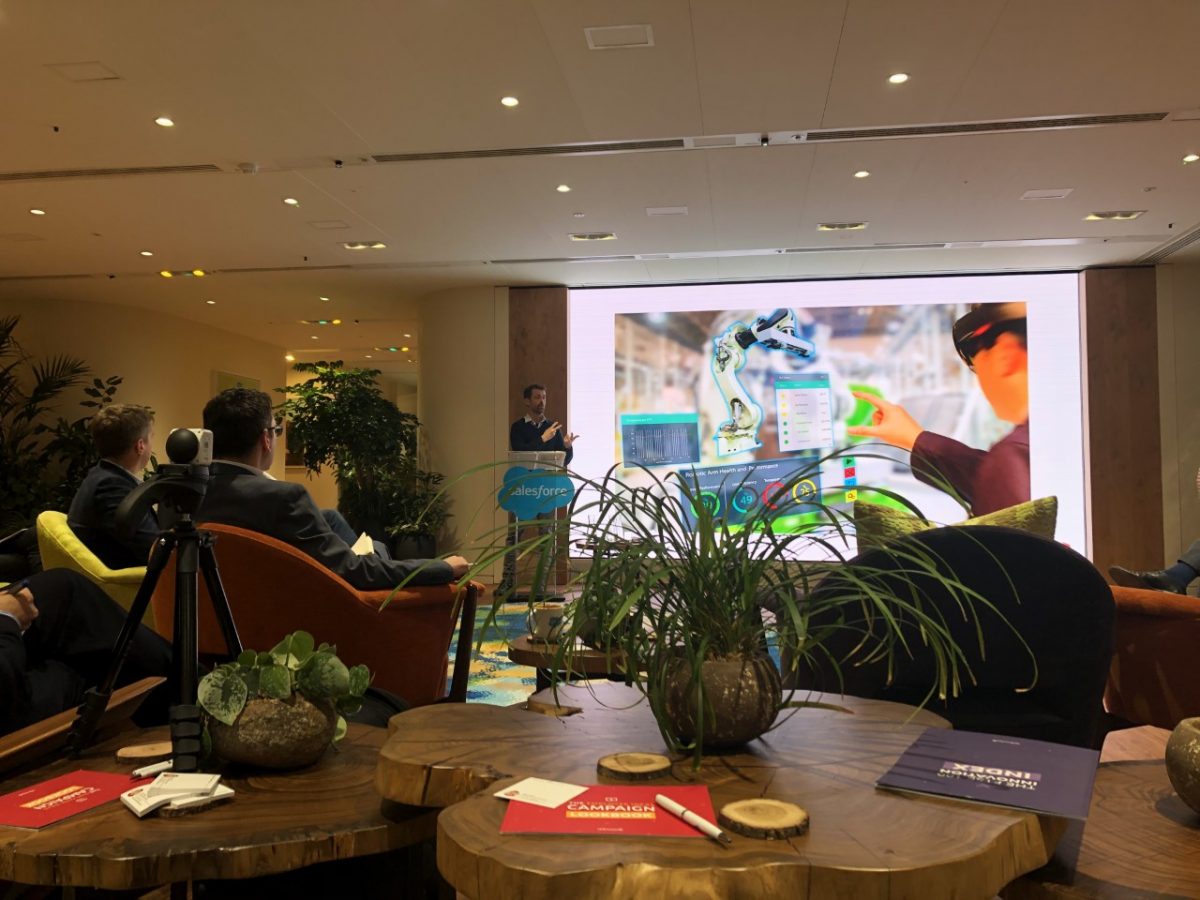MXTreality Managing Director Toby Pettinger was invited to present on the subject of Immersive Technology to an invited audience of Construction Industry CIOs at Salesforce Tower, hosted by Mark Cotton, CIO of Galliford Try.
Attendees enjoyed a compelling employee engagement presentation from Sideways 6, a company committed to helping build better businesses through employee ideas and a business round-up presentation from BAM Nuttall, one of the largest construction and civil engineering companies.
Do not buy Immersive Technology
From our perspective, the main event was the presentation on Immersive Technology by our Managing Director Toby Pettinger, who started by advising all those present not to buy Immersive Technology, or Immersive Technology hardware, or Immersive Technology software; not even Immersive Technology solutions.
An interesting start and one that grabbed everyone’s attention. He was addressing the common mistake made by organisations during the early stages of a technology revolution; the tendency to make purchases hastily for fear of being left behind or being seen to not understand.
This approach rarely works and even more rarely delivers the expected outcomes or any tangible return on the investment.
Immersive Technology needs to be seen as the new computing platform and investigated as such. Look beyond the hype, the hardware, off-the-shelf offerings, and find the right expert advisor. They’ll work with you to best understand your organisation’s key requirements and how Immersive Technology can be most cost-effectively applied to address them.
Get the biggest bang for your buck.
Advice shaped by experience
Toby first explained carefully what the various acronyms used in our world mean and what most people understand by them:
Virtual Reality (VR) – this offers full immersion with a headset and is typically used for one off rollercoaster experiences and similar, or used to cover either 360 film or CGI environments in which the user is totally immersed.
Augmented Reality (AR) – which offers an enhanced real world experience, using a phone, ipad or headset, typically using characters, small animations or information of some sort, which is overlaid on the real world in the user’s field of view.
Mixed Reality (MR) – the basis of our company name, where users interact with the real world using a combination of VR & AR elements to deliver a more complex, immersive experience, like those we create for our clients.
What you should do
Having warned of the dangers of buying technology just for the sake of it, Toby went on to explain how organizations should ignore the appeal of headsets, handsets, etc., and approach the concept of immersive technology (Imtech or Spatial Computing).

Firstly, you have to work out what you really want as a business; don’t focus on the headsets and the peripheral hardware. Then make a business case for adoption, one you can put in front of other members of your management team. Identify the actions likely to deliver the best return on your investment.
Finally, ensure it can be deployed successfully and there is a real-use case that will deliver cost-savings, increase efficiency, improve training, shorten adoption periods, etc.
But it’s not just about practical tasks, like safety training.
Numerous studies have been undertaken into the efficacy of Immersive Technologies in various applications.
As an example; the appropriate use of immersive technologies can change attitudes – spending just a short time as a homeless person in a virtual urban environment, with the associated feelings, sights and sounds has been shown to create longer-term empathy compared to any number of videos on the subject.
Immersive Technology and the Construction Industry
The Construction Industry, actually, has been one of the Early Adopters of Immersive Technology as an evolution from the well-trodden “Visualisation” models.
There are a myriad of modelling softwares used in the Construction Industry but these can cause issues when working across numerous stakeholders, each using a different software package; they are often incompatible.
As far back as 2012 we were taking output from all of these packages and bringing them together as a single, coherent, immersive model. For years we have taken visualisation a couple of steps further, to allow architects, engineers, construction companies and their clients, experience what it was they were planning. We’ve been helping people avoid mistakes before planning was finalised or a brick was laid.
In one such example, we created an immersive environment based on the plans for a landmark hotel’s roof terrace, with all the walkways laid out exactly as planned to allow the architects, engineers and designers to view the finer details in a mixed reality world.
With a bespoke user interface, the key stakeholders were able to tour the roof gardens and as a result we revealed errors in accessibility and an impeded view saving hundreds of thousands of dollars in costly mistakes.
The final word
In conclusion, we don’t sell VR hardware, we don’t sell VR software and we don’t build boilerplate solutions in the hope that someone might buy them. We work with the majority of headsets and we work with peripheral hardware and 4D experiential solutions that most do not have. That means that we know exactly what can be achieved and we have examples of use for most.
Some of the largest organisations in the world come to MXTreality because we help them navigate the world of Immersive Technology as advisors and as producers of bespoke solutions designed to fit their specific needs.
Far from being the more expensive route this means that our clients get exactly what they need, deployed in a way appropriate to their organisation, first time.
If you want to know more, please get in touch and we’ll demonstrate just how much is possible with an immersive environment tailored to your specific needs.

